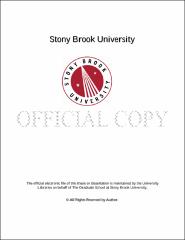| dc.identifier.uri | http://hdl.handle.net/11401/77391 | |
| dc.description.sponsorship | This work is sponsored by the Stony Brook University Graduate School in compliance with the requirements for completion of degree. | en_US |
| dc.format | Monograph | |
| dc.format.medium | Electronic Resource | en_US |
| dc.language.iso | en_US | |
| dc.publisher | The Graduate School, Stony Brook University: Stony Brook, NY. | |
| dc.type | Dissertation | |
| dcterms.abstract | Understanding the evolution of complex traits and the generation of biodiversity are fundamental goals of evolutionary biology. One issue with studying these phenomena is the tractability of large scale experiments. The goal of this dissertation is to use a set of wild and industrial strains of the budding yeast Saccharomyces cerevisiae to explore the genotypic and phenotypic variation in carbon metabolism. I first used publicly available data to measure variation in carbon metabolism traits, the ability to use a carbon source, across the genus Saccharomyces. Additionally, I assessed whether these traits displayed patterns of coordinated gain and loss and what factors were driving these patterns. Next, I used of wild and industrial strains of S. cerevisiae to quantify variation in growth rates among carbon metabolism traits across single carbon environments and multi-dimensional conditions. The use of wild and industrial strains and the use of multi-dimensional conditions provided a level of environmental complexity that cannot be achieved with laboratory strains under single condition perturbations. These data, along with genomic data provided insight into how genotypic variation is translated into phenotypic variation. My results demonstrated significant variation for carbon metabolism among strains and strong non-additive growth rate interactions among multi-dimensional conditions. Furthermore, I found associations between growth rate and gene presence and copy number variation. The niche breadth demonstrated by these strains provided the opportunity to further our understanding of mutational robustness, the ability to maintain function in the presence of genetic perturbations. I mutated a subset of strains used in the previous set of experiments using the mutagen Ethyl methansulfonate and compared relative survivorship and growth rates of ancestral and mutant lines to explore whether mutational robustness varied within a species. I found that strains displayed significant variation in mutational robustness. This is the first example of mutational robustness being measured within a species. Next, I examined whether mutational robustness and niche breadth were correlated and found a positive correlation between them. These results suggest mutational robustness is a by-product of selection for increased niche breadth (environmental robustness). | |
| dcterms.available | 2017-09-20T16:52:37Z | |
| dcterms.contributor | Dykhuizen, Daniel | en_US |
| dcterms.contributor | Rest, Joshua S | en_US |
| dcterms.contributor | Eanes, Walter F | en_US |
| dcterms.contributor | Durand, Dannie. | en_US |
| dcterms.creator | Opulente, Dana Ann | |
| dcterms.dateAccepted | 2017-09-20T16:52:37Z | |
| dcterms.dateSubmitted | 2017-09-20T16:52:37Z | |
| dcterms.description | Department of Ecology and Evolution. | en_US |
| dcterms.extent | 129 pg. | en_US |
| dcterms.format | Application/PDF | en_US |
| dcterms.format | Monograph | |
| dcterms.identifier | http://hdl.handle.net/11401/77391 | |
| dcterms.issued | 2015-05-01 | |
| dcterms.language | en_US | |
| dcterms.provenance | Made available in DSpace on 2017-09-20T16:52:37Z (GMT). No. of bitstreams: 1
Opulente_grad.sunysb_0771E_12336.pdf: 4158767 bytes, checksum: 9d8fc232c6e78fac9a2358112fd21d74 (MD5)
Previous issue date: 2015 | en |
| dcterms.publisher | The Graduate School, Stony Brook University: Stony Brook, NY. | |
| dcterms.subject | Evolution & development | |
| dcterms.title | Genotypic and phenotypic variation in carbon metabolism and niche breadth in wild and industrial strains of Saccharomyces cerevisiae | |
| dcterms.type | Dissertation | |

